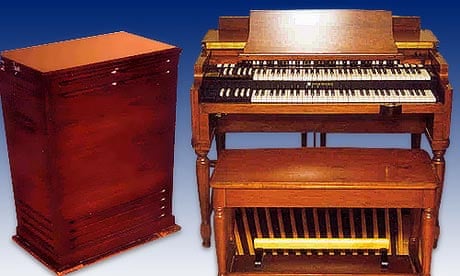What is it? The most iconic and greatest of all organs! The Hammond has been described as both cool and cheesy over the decades, but its singular appeal has endured well into the organ's seventh decade.
Who uses it? Gospel soars on the Hammond, it's the spangly grot under the fingernails of rhythm and blues and garage rock, it adds a whirling psychedelic mania to prog and a reassuring, inoffensive toot to the parp of British music hall, and any and all of those things to jazz. We've compiled a megalithic Spotify playlist.
How does it work? Tonewheels! Inventor Laurens Hammond turned his hand to many odd things before he had a go at making a low-cost pipe-less church organ, and his ingenious solution to replicating the harmonic frequencies of the pipe organ came from an unusual place. Hammond began to recognise the different tones generated by the cogs in his clocks, and found that he could generate tones by placing a mechanically rotating wheel next to an electromagnetic pick-up. In an attempt to mimic the massed pipes of the church organ, Hammond allocated nine mechanical wheels to each key on the keyboard, and then added a series of "drawbar" controllers that could fade in or out any of the frequencies created by the different tonewheels, allowing millions of potential combinations.
Where does it come from? Laurens unveiled his contraption in 1934, and it found some popularity in American churches and later as a kitsch live accompaniment in British ice rinks. The Hammond's real heyday, though, was in the time of the B3 model, produced from 1954 to 1974.
Why is it classic? Musicians like Steve Winwood and Keith Emerson found that the Hammond could power their rock songs up with a blaring, almost vocal organ tone that – thanks to the instrument's ever-grinding motor – could be incessant and surging, as well as soulful. But its a versatile organ too, and the mode of the Hammond's deployment really varies across many genres.
What's the best ever Hammond organ song? There are just too many. But let's just say that if you don't get Winwood's work on Gimme Some Loving by the Spencer Davis Group, then you'll never get the Hammond.
Five facts and things
Who was the first musician to unleash the creativity of the Hammond? That would be jazz organist Jimmy Smith. Before Smith, the Hammond had a distinctly more conservative role in chapels, theatres and for providing music and sound effects in radio plays. Smith's dazzling virtuoso grasp of the pedals and drawbars of the Hammond led the organ to infect jazz, gospel, soul and blues, before crossing over and being mangled by rock.
Roadie to the stars, Lemmy (yes THAT one) encouraged the Nice and future-ELP keyboardist Keith Emerson to smash his Hammond around the stage Hendrix-style, going as far as to provide him with Hitler Youth knife to stab at the keys. Other rockers inspired to Hammond-up their sound include Deep Purple, Procol Harum, Yes, Genesis, the Small Faces, Eloy, Nick Cave and the Bad Seeds, Pink Floyd, Grateful Dead, Bruce Springsteen, the Stranglers, Evanescence, and the Charlatans were officially the only good indie band to ever use a Hammond.
So what was so great about the B3? It was the B3 that Hammond enthusiasts began combining with the Leslie speaker – a spinning horn, the rotation of which can be sped up or slowed down to create effects from tremolo to chorus. Although Laurens was initially aghast at the pairing, it was the combination of the Leslie speaker and the Hammond that gave 1960s jazz and rock its overdriven, scrambled organ tone.
Production of the classic tonewheel organs ceased in the 1970s, but in 2002, with the reputation of the B3 towering over its 20-odd siblings, "The New B3" was issued. A conscious attempt to mimic the sound and functionality of the B3, but with modern electronic (rather than clunkier, motors-and-cogs components. Jimmy Smith lent his official seal of approval and the B3's descendent was well-received by musicians.
The Hammond, like a beloved but juddering old car, usually takes a while for the motor to start up and get going. Many Hammond players have used this to their advantage though, getting interesting wobbly pitch bends or revving engine noises by flicking the motor on and off mid-riff.
